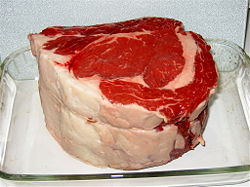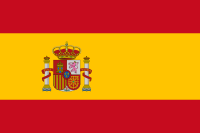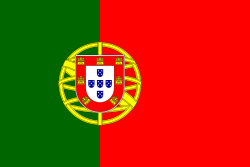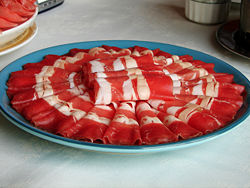Beef

Beef is the culinary name for meat from bovines, especially domestic cattle (cows). Beef is one of the principal meats used in the cuisine of Australia, Europe and the Americas, and is also important in Africa, East Asia, and Southeast Asia. In the Middle East, lamb is usually preferred over beef. Consuming beef is more or less universally forbidden by Hindus as bovines are revered throughout many Hindu religious traditions. It is also discouraged among some Buddhists.
Beef muscle meat can be cut into steaks, pot roasts or short ribs, or it can be ground/minced. The blood is used in some varieties of blood sausage. Other parts which are eaten include the meaty tail, tongue, tripe from the stomach,glands—particularly the pancreas and thymus—referred to as sweetbreads, the heart, the brain (although forbidden where there is a danger of bovine spongiform encephalopathy, BSE), the liver, the kidneys, the tender testicles of the bull (known in the US as "calf fries", "prairie oysters", or "Rocky Mountain oysters"), intestines, and the udder. Beef bones are used for making soup stock.
The better cuts are usually obtained from the steer; the heifer tends to be kept for breeding. Older animals are used for beef when they are past their reproductive prime. The meat from older cows and bulls is usually tougher, so it is frequently used for mince (UK)/ground beef (US). Cattle raised for beef may be allowed to roam free on grasslands, or may be confined at some stage in pens as part of a large feeding operation called a feedlot, where they are usually fed grain.
The United States, Brazil, Japan and the People's Republic of China are the world's four largest consumers of beef.[1] The world's largest exporters of beef are Australia, Brazil, Argentina and Canada.[2] Beef production is also important to the economies of Uruguay, Nicaragua, Russia and Mexico.
Contents |
History
The flesh of bovines has been eaten by hunters from prehistoric times, some of the earliest known cave paintings such as those of Lascaux show aurochs in hunting scenes. Domestication of cattle occurred around 8000 BC,providing ready access to beef, milk and leather.[3] Most cattle originated in the Old World with the exception of bison hybrids. Examples include the Wagyu from Japan, Ankole-Watusi from Egypt, and longhorn Zebu from the Indian subcontinent.[4] Cattle were widely used for meat across the Old World. Some breeds were specifically bred to increase meat yield or improve texture like the Murray Grey, Angus or Wagyu, etc.
Etymology
After the Norman Conquest, the nobles who ruled England naturally used French words to refer to the meats they were served, so the animal called cu (cow) by the Anglo-Saxon peasants—who, it seems, rarely got to eat one—was called boeuf (ox) by the French nobles—who did not often deal with the live animal—when it was served to them for dinner. This is one example of the common English dichotomy between the words for animals (with largely Germanic origins) and their meat (with Romanic origins) that is also found in such English word-pairs swine/pork and sheep/mutton.[5]
Cuts of beef
Beef is first divided into primal cuts. These are basic sections from which steaks and other subdivisions are cut. Since the animal's legs and neck muscles do the most work, they are the toughest; the meat becomes more tender as distance from "hoof and horn" increases. Different countries have different cuts and names.
See the external links section below for links to more beef cut charts and diagrams.
American primal cuts

The following is a list of the American primal cuts, ordered front to back, then top to bottom. The short loin and the sirloin are sometimes considered as one section.
Upper half
- Chuck — one of the most common sources for hamburgers.
- Rib — short ribs, rib eye steak.
- Short loin — from which porterhouse steaks are cut.
- Sirloin — less tender than short loin, but more flavorful.
- Tenderloin — the most tender, from which filet mignon is served.
- Top sirloin
- Round — lean cut, moderately tough. Lack of fat and marbling does not allow round steak to tenderize quickly.
Lower half
- Brisket — often associated with barbecue beef brisket.
- Shank — used primarily for stews and soups; it is not usually served any other way due to it being the toughest of the cuts.
- Plate — produces short ribs for pot roasting and types of steak such as the outside skirt steak [fajitas] and hanger steak. It is typically a cheap, tough, and fatty meat.
- Flank — used mostly for grinding, except for the long and flat flank steak, best known for use in London broil. Once one of the most affordable steaks on the market, it is substantially tougher than the loin and rib steaks, therefore many flank recipes use marinades or moist cooking methods such as braising. Popularity and leanness have resulted in increased price.
British Prime Cuts

- Neck & clod
- Chuck & blade
- Rib
- Silver loin
- Rump
- Silverside
- Topside
- Thick rib
- Thin rib
- Brisket
- Shin
- Flank
- Thick flank
- Leg
Special beef designations

- Certified Angus Beef Certified Angus Beef (CAB) is a specification-based, branded-beef program which was founded in 1978 by Angus cattle producers to increase demand for their breed of cattle, by promoting the impression that Angus cattle have consistent, high-quality beef with superior taste. The brand is owned by the American Angus Association and its 35,000 rancher members. The terms "Angus Beef" or "Black Angus Beef" are loosely and commonly misused and/or confused with CAB; this is especially common in the foodservice industry. The brand or name Certified Angus Beef can't be legally used by an establishment that is not licensed to do so. However Black Simmental beef may also be included in the certified angus beef program.
- Certified Hereford Beef is beef certified to have come from Hereford cattle.
- Grass fed beef has been raised primarily on forage rather than in a feedlot.
- Kobe beef : Cattle of the Wagyu breed raised and fattened in the hills above Kobe, Hyōgo Prefecture, Japan. During the fattening period, the cattle are hand-fed (using high-energy feed, including beer and beer mash) and hand-massaged for tenderness and high fat content.
- Halal beef (and other food) has been certified to have been processed in a prescribed manner in accordance with Muslim dietary laws.
- Kosher beef (and other food) has been certified to have been processed in a prescribed manner in accordance with Jewish dietary laws.
- Organic beef is produced without added hormones, pesticides, or other chemicals, though requirements for labeling something "organic" vary widely.
- The
 European Union recognises the following Protected Designation of Origin beef brands[6]
European Union recognises the following Protected Designation of Origin beef brands[6]
-
 Spain - Carne de Ávila, Carne de Cantabria, Carne de la Sierra de Guadarrama, Carne de Morucha de Salamanca, Carne de Vacuno del País o Euskal Okela
Spain - Carne de Ávila, Carne de Cantabria, Carne de la Sierra de Guadarrama, Carne de Morucha de Salamanca, Carne de Vacuno del País o Euskal Okela France - Taureau de Camargue, Boeuf charolais du Bourbonnais, Boeuf de Chalosse, Boeuf du Maine
France - Taureau de Camargue, Boeuf charolais du Bourbonnais, Boeuf de Chalosse, Boeuf du Maine Portugal - Carne Alentejana, Carne Arouquesa, Carne Barrosã, Carne Cachena da Peneda, Carne da Charneca, Carne de Bovino Cruzado dos Lameiros do Barroso, Carne dos Açores, Carne Marinhoa, Carne Maronesa, Carne Mertolenga, Carne Mirandesa
Portugal - Carne Alentejana, Carne Arouquesa, Carne Barrosã, Carne Cachena da Peneda, Carne da Charneca, Carne de Bovino Cruzado dos Lameiros do Barroso, Carne dos Açores, Carne Marinhoa, Carne Maronesa, Carne Mertolenga, Carne Mirandesa United Kingdom - Orkney Beef, Scotch Beef, Welsh Beef
United Kingdom - Orkney Beef, Scotch Beef, Welsh Beef
USDA beef grades

In the United States, the USDA operates a voluntary beef grading program. The meat processor pays for a trained USDA meat grader to grade whole carcasses at the abattoir. Users are required to comply with Food Safety and Inspection Service (FSIS) grade labeling procedures. The official USDA grade designation can appear in one or any combination of the following ways: container markings, individual bags, legible roller brand appearing on the meat itself, or by a USDA shield stamp that incorporates the quality and/or yield grade.
There are eight beef quality grades. The grades are based on two main criteria: the degree of marbling (intramuscular fat) in the beef, and the estimated age of the animal at slaughter(maturity). Some meat scientists object to the current scheme of USDA grading since it is not based on direct measurement of tenderness, although marbling and maturity are indicators of tenderness. Most other countries' beef grading systems mirror the US model. Most beef offered for sale in supermarkets is graded choice or select. Prime beef is sold to hotels and upscale restaurants. Beef that would rate as Standard or less is almost never offered for grading.
- U.S. Prime - Highest in quality and intramuscular fat, limited supply. Currently, only two percent of carcasses grade as Prime.
- U.S. Choice - High quality, widely available in foodservice industry and retail markets.
- U.S. Select (formerly "Good") - lowest grade commonly sold at retail, acceptable quality but less juicy and tender due to leanness.
- U.S. Standard - Lower quality yet economical, lacking marbling.
- U.S. Commercial - Low quality, lacking tenderness, produced from older animals.
- U.S. Utility
- U.S. Cutter
- U.S. Canner
Utility, Cutter, and Canner grade are rarely used in foodservice operations and primarily used by processors and canners.
Traditionally, beef sold in steakhouses and supermarkets has been advertised by its USDA grading; however, many restaurants and retailers have recently begun advertising beef on the strength of brand names and the reputation of a specific breed of cattle, such as black angus.[7][8]
Cooking and preparing beef
The method of cooking beef is largely determined by the cut of beef to be cooked. For example, tender (and generally more expensive) cuts of meat benefit from fast, high-heat cooking while tough cuts benefit from a slower and longer cooking method.
Cooking with dry heat

Tender cuts of beef from the loin and rib are best cooked via dry cooking methods, such as charcoal grilling, broiling, roasting, and sautéing
- Grilling is cooking the beef over or under a high radiant heat source, generally in excess of 650 °F (343 °C). This leads to searing of the surface of the beef, which creates a flavorful crust. In the U.S.A., Australia, Canada, and the UK grilling, particularly over charcoal, is sometimes known as "barbecuing", often shortened to "BBQ."
- Broiling is similar to grilling, but specifically with the heat source above the meat.
- Roasting is a particularly British way of cooking meat in a hot oven, producing roast beef. Liquid is not usually added; the beef may be basted by fat on the top, or by spooning hot fat from the oven pan over the top. A gravy may be made from the cooking juices, after skimming off excess fat.
- Stirfrying is a Chinese and oriental way of cooking. Cooking oil with flavourings such as garlic, ginger and onions are put in a very hot wok. Then slices of meat are added, followed by ingredients which cook quicker: mixed vegetables, etc. The dish is ready when the ingredients are 'just cooked'.
Internal temperature
Grilled or roast beef can be cooked to various degrees, from very rare to well done. The degree of cooking corresponds to the temperature in the approximate center of the meat, which can be measured with a meat thermometer.
| Cooked: | Temperature | Description |
|---|---|---|
| Very rare | 115 – 125°F (46 – 52°C) | Blood-red meat, soft, very juicy |
| Rare | 125 – 130°F (52 – 54°C) | Red center, gray surface, soft, juicy |
| Medium rare | 130 – 140°F (54 – 60°C) | Pink throughout, gray-brown surface, often remains juicy |
| Medium | 140 – 150°F (60 – 66°C) | Pink center, becomes gray-brown towards surface |
| Medium well | 150 – 160°F (66 – 71°C) | Thin line of pink, firm texture. |
| Well done | >160°F (>71°C) | Gray-brown throughout, tough texture. |
Cooking with moist heat
Tougher cuts of beef from the round, brisket, flank, plate, shank, shin, leg, and chuck are best cooked by moist heat cooking methods, such as braising, pot roasting, and stewing. Some of the tougher cuts may be prepared with dry heat if they are first tenderized with a marinade, or cooked for a long time at a low temperature.
- Stewing is simmering meat, whole or cut into bite-size pieces, in a water-based liquid with flavourings.
- Braising is cooking meats, in a covered container, with small amounts of liquids (usually seasoned or flavored). Unlike stewing, braised meat is not fully immersed in liquid.
Meat has usually been cooked in water which is just simmering; higher temperatures make meat tougher. Since thermostatic temperature control became available, cooking at temperatures well below boiling, 65 °C (149 °F) to 90 °C (194 °F), for prolonged periods has become possible; this is just hot enough to dissolve connective tissue and kill bacteria, with minimal toughening.
Raw beef

Steak tartare is a French dish made from finely chopped or ground raw meat (often beef). It is often served with onions, capers, seasonings like fresh ground pepper and Worcestershire sauce, and sometimes raw egg. The Belgian dish filet américan is also made of finely chopped ground beef, though it is seasoned differently, and either eaten as a main dish or can be used as a dressing for a sandwich. Kibbeh nayyeh is a similar Middle-Eastern dish. And, in Ethiopia, a ground raw meat dish called Kitfo is eaten.
Carpaccio of beef is a thin slice of raw beef dressed with olive oil, lemon juice and seasoning. Often the beef is partially frozen before slicing to allow very thin slices to be cut.
Yukhoe is a variety of hoe, raw dishes in Korean cuisine which is usually made from raw ground beef seasoned with various spices or sauces. The beef part used for yukhoe is tender rump steak. For the seasoning, soy sauce, sugar, salt, sesame oil, green onion, and ground garlic, sesame seed, black pepper and juice of bae (Korean pear) are used. The yolk of a raw egg is mostly topped on the beef.
Cured or smoked beef
Bresaola is an air-dried salted beef that has been aged about 2-3 months until it becomes hard and a dark red, almost purple colour. It is lean, has a sweet, musty smell and is tender. It originated in Valtellina, a valley in the Alps of northern Italy's Lombardy region. Bündnerfleisch is a similar product from neighbouring Switzerland.
Pastrami is often made from beef, the raw beef is salted, then partly dried and seasoned with various herbs and spices and smoked.
Corned beef is a cut of beef cured or pickled in a seasoned brine. The "corn" in "corned beef" refers to the "corn" or grains of coarse salts used to cure it. The term "corned beef" can denote different styles of brine-cured beef, depending on the region. Some, like American-style corned beef, are highly seasoned and often considered delicatessen fare.
Beef jerky is dried, salted, smoked beef popular in the United States.
Biltong is a cured, salted, air dried beef popular in South Africa.
Religious Prohibitions
As a general rule, followers of Hinduism, Theravadan Buddhism, Jainism and Sikhism do not eat Beef. Bovines are highly revered as "sacred" to mankind since the early human civilisation in the Indus Valley Civilization. Their role as a source of milk, dairy products and animal power is also appreciated. Thus, the cow is revered amongst Hindus. See also Cattle in religion, Nandi (Bull), and Kamadhenu. There is not any religious significance of cows in Sikhism, but many Sikhs are vegetarian, just in light of the Hindu friends around them.
Nutrition and health
Beef is rich in zinc, selenium, phosphorous, iron, and B vitamins.[9] Red meat is the most significant dietary source of carnitine. And may also be along with avoacadoes one of the only sources of creatine.
Health concerns
A study released in 2007 by the World Cancer Research Fund reported “strong evidence that red meat and processed meats are causes of bowel cancer” and recommends that people eat less than 500 grams (18 oz) of cooked red meat weekly, and as little processed meat as possible. The report also recommends that average consumption in populations should not exceed 300 grams (11 oz) per week, stating that this goal "corresponds to the level of consumption of red meat at which the risk of colorectal cancer can clearly be seen to rise."[10] Lean beef, with its high selenium and B12 content, may actually lower the risk of colon cancer.[9]
The Harvard School of Public Health recommends that consumers eat red meat sparingly as it has high levels of undesirable saturated fat.[11] Like some other animal products (such as whole milk), red meat provides a rich source of the heart-healthy fat conjugated linoleic acid along with the saturated fat. Beef's high content of B6 and B12 may help lower homocysteine.[9]
Mad cow disease
In 1984 the use of meat and bone meal in cattle feed resulted in the world's first outbreak of bovine spongiform encephalopathy (BSE or, colloquially, mad cow disease) in the United Kingdom.[12] Eating beef from cattle with BSE is thought to have caused a variant of Creutzfeldt-Jakob disease (vCJD) in about 131 cases (2003 June data) in the United Kingdom and a few in France. BSE is an illness that cattle can contract when they are fed infected animals (especially the brains and spinal cords). The perception of beef as potentially-lethal damaged the UK beef industry. Attempts to wipe out BSE in the UK by a slaughter-and-burn campaign further damaged the beef industry.
Since then, other countries have had outbreaks of BSE:
- In May 2003, after a cow with BSE was discovered in Alberta, Canada, the American border was closed to live Canadian cattle in May 2003 and reopened in early 2005.[13]
- Many countries stopped importing United States beef and beef products. On July 27, 2006 Japan allowed imports again.
See also
- 2006 Argentine restriction of beef exports
- Argentine beef
- Beef Jerky
- Entrecôte
References
- ↑ "Major Countries Beef Production and Consumption" (PDF). Retrieved on 2008-05-03. USDA PDF
- ↑ "World Beef Overview". Retrieved on 2008-05-03. USDA
- ↑ "Late Neolithic megalithic structures at Nabta Playa". Retrieved on 2008-02-27.
- ↑ "History of Cattle Breeds". Retrieved on 2007-04-17.
- ↑ The American Heritage Dictionary of the English Language, Fourth Edition, 2000: beef.
- ↑ "Protected Designation of Origin (PDO) / Protected Geographical Indication (PGI)". Retrieved on 2007-08-10.
- ↑ "Branded Beef Booming", Denver Post (2003-06-17). Retrieved on 2007-04-17.
- ↑ Michael Chu. "USDA Beef Quality Grades". Cooking for Engineers. Retrieved on 2007-08-10.
- ↑ 9.0 9.1 9.2 http://whfoods.org/genpage.php?pfriendly=1&tname=foodspice&dbid=141
- ↑ 2007 report by the World Cancer Research Fund
- ↑ Harvard School of Public Health – Healthy Eating Pyramid
- ↑ "Timeline: BSE and vCJD". NewScientist.com news service (13 December 2004). Retrieved on 2007-08-10.
- ↑ Canadian beef industry loses patience over border dispute
External links
- USDA beef grading standards (PDF)
- Nutrition Facts for Various Cuts of Beef
- Many different meat cut charts
- Your Premier Beef Discussion Forum
- The Story of Beef in Nebraska, the Beef State with videos, history, life cycle, issues, and culture